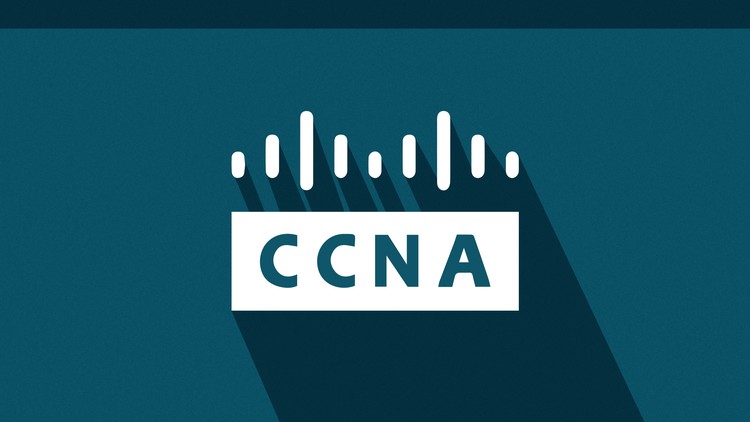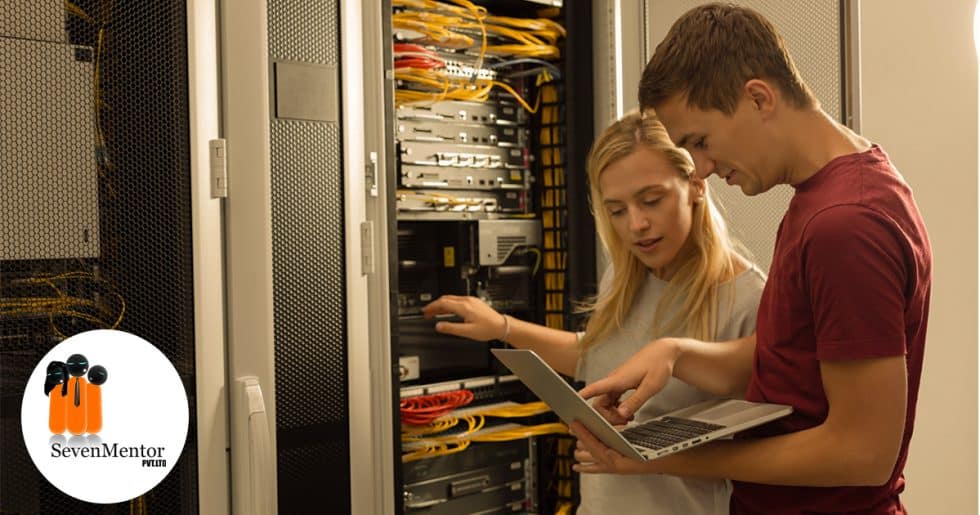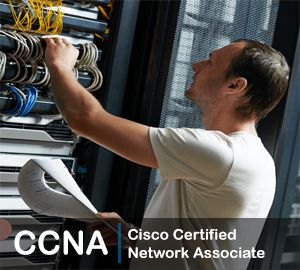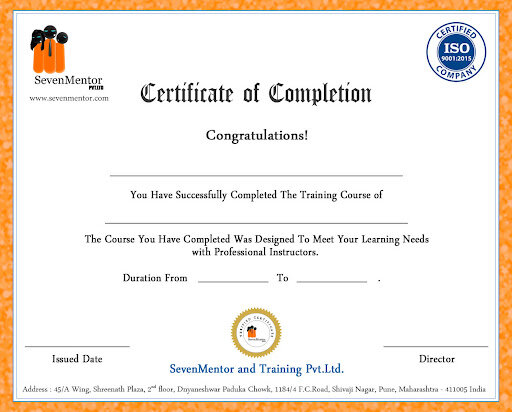CCNA Routing And Switching
The Cisco Certified Network Associate (CCNA) certification is the next degree of Cisco's five-level profession certification procedure. It's an ideal starting point for people looking to enhance their career in IT and networking. Get the best CCNA Training in Nashik from the CISCO Certified experts.
Call The Trainer
Batch Timing
- Regular: 2 Batches
- Weekends: 2 Batches
Request Call Back
Class Room & Online Training Quotation
About CCNA R&S
CCNA Course In Nashik offers you a wide selection of basic knowledge for all IT careers. You are going to learn how to install, operate, configure, and confirm a basic IPv4 and IPv6 network. The class covers configuring network elements such as switches, routers, along with Wireless LAN Controllers; managing network devices; and identifying fundamental security dangers. The class also provides you a base in community programmability, automation, and also software-defined media. This course helps you prepare to take the 200-301 Cisco Certified Network Associate (CCNA) examination to make CCNA certification..
The Cisco Certified Network Associate (CCNA) certification is the next degree of Cisco's five-level profession certification procedure. It's an ideal starting point for people looking to enhance their career in IT and networking. CCNA certification demonstrates a technician's ability to install, setup, configure, troubleshoot and operate a medium-sized routed and switched computer network. This also involves executing and verifying connections to a wide area network (WAN).
COURSE OBJECTIVES
After taking this course, you should be able to:
A CCNA certification also opens up a range of networking and IT career options. Organizations regularly look for CCNA-certified specialists due to their ability to help with network infrastructure design, development, and administration.
If you hold this qualification, you can get entry-level or mid-level jobs that pay more than non-certified positions. You can choose between positions with titles like Network Engineer, Systems Engineer, Security Analyst, and Network Administrator.
The typical pay for those with CCNA certification varies depending on the industry, region, degree of experience, and kind of employment. Nonetheless, employees with CCNA certification typically earn more money than those without certification in equivalent roles.
Who should attend this CCNA Training Course?
This certificate is intended for individuals seeking to get CCNA Routing and Switching certification. This course is also suitable for support technicians involved in the basic setup, operation, and affirmation of LAN networks
Online Classes
The CCNA R&S online certification validates the ability to install, configure, operate, and troubleshoot medium-size routed and switched networks. CCNA certified professionals have the knowledge and skills to make connections to remote sites through a WAN, and mitigate fundamental security threats. CCNA R&S online training in Nashik covers (but isn't limited to) using those themes: IOS, IPv6, IPv4, OSPF, Cisco Licensing, Enhanced Interior Gateway Routing Protocol (EIGRP), Serial Line Interfaces, Frame Relay interfaces VLANs, Ethernet, VLSM, and basic traffic filtering
SevenMentor's online CCNA R&S Training provides a comprehensive overview of networking, from fundamentals to advanced applications and services, while providing opportunities to gain the skills and hands-on experience to design, install, operate, and maintain IT networks
Course Eligibility
There is no such criteria for joining Online CCNA Training. CCNA is an associate or entry level certification exam for those who are planning to build their career in the most demanding field of networking.
- 10+2 students can go for CCNA Training
- Undergraduates and graduates
- Professionals who want switch
- Those who are interested in Networking
Syllabus CCNAR&S
Cisco Certified Network Associate (200-301)
Exam Description: The Cisco Certified Network Associate (CCNA) Routing
and Switching composite exam (200-301) is a 90-minute, 50–60 question
assessment that is associated with the CCNA Routing and Switching
certification. This exam tests a candidate's knowledge and skills related to
network fundamentals, LAN switching technologies, IPv4 and IPv6 routing
technologies, WAN technologies, infrastructure services, infrastructure
security, and infrastructure management .The following topics are general guidelines for the content likely to be
included on the exam. However, other related topics may also appear on any
specific delivery of the exam. In order to better reflect the contents of the
exam and for clarity purposes, the guidelines below may change at any time
without notice.
15% 1.0 Network Fundamentals
21% 2.0 LAN Switching Technologies
23% 3.0 Routing Technologies
10% 4.0 WAN Technologies
10% 5.0 Infrastructure Services
11% 6.0 Infrastructure Security
10% 7.0 Infrastructure Management
- 1.0 Network Fundamentals
- 1.1. Compare and contrast OSI and TCP/IP models
- 1.2. Compare and contrast TCP and UDP protocols
- 1.3. Describe the impact of infrastructure components in an enterprise network
- 1.3.1. Firewalls
- 1.3.2. Access points
- 1.3.3. Wireless controllers
- 1.4. Describe the effects of cloud resources on enterprise network architecture
- 1.4.1. Traffic path to internal and external cloud services
- 1.4.2. Virtual services
- 1.4.3. Basic virtual network infrastructure
- 1.5. Compare and contrast collapsed core and three-tier architectures
- 1.6. Compare and contrast network topologies
- 1.6.1. Star
- 1.6.2. Mesh
- 1.6.3. Hybrid
- 1.7. Select the appropriate cabling type based on implementation requirements
- 1.8. Apply troubleshooting methodologies to resolve problems
- 1.8.1. Perform and document fault isolation
- 1.8.2. Resolve or escalate
- 1.8.3. Verify and monitor resolution
- 1.9. Configure, verify, and troubleshoot IPv4 addressing and subnetting
- 1.10. Compare and contrast IPv4 address types
- 1.10.1. Unicast
- 1.10.2. Broadcast
- 1.10.3. Multicast
- 1.11. Describe the need for private IPv4 addressing
- 1.12. Identify the appropriate IPv6 addressing scheme to satisfy< addressing requirements in a LAN/WAN environment
- 1.13. Configure, verify, and troubleshoot IPv6 addressing
- 1.14. Configure and verify IPv6 Stateless Address Auto Configuration
- 1.15. Compare and contrast IPv6 address types
- 1.15.1. Global unicast
- 1.15.2. Unique local
- 1.15.3. Link local
- 1.15.4. Multicast
- 1.15.5. Modified EUI 64
- 1.15.6. Autoconfiguration
- 1.15.7. Anycast
- LAN Switching Technologies
- 2.1. Describe and verify switching concepts
- 2.1.1. MAC learning and aging
- 2.1.2. Frame switching
- 2.1.3. Frame flooding
- 2.1.4. MAC address table
- 2.2. Interpret Ethernet frame format
- 2.3. Troubleshoot interface and cable issues (collisions, errors, duplex, speed)
- 2.4. Configure, verify, and troubleshoot VLANs (normal/extended range) spanning multiple switches
- 2.4.1. Access ports (data and voice)
- 2.4.2. Default VLAN
- 2.5. Configure, verify, and troubleshoot interswitch connectivity
- 2.5.1. Trunk ports
- 2.5.2. Add and remove VLANs on a trunk
- 2.5.3. DTP, VTP (v1&v2), and 802.1Q
- 2.5.4. Native VLAN
- 2.6. Configure, verify, and troubleshoot STP protocols
- 2.6.1. STP mode (PVST+ and RPVST+)
- 2.6.2. STP root bridge selection
- 2.7. Configure, verify and troubleshoot STP related optional features
- 2.7.1. PortFast
- 2.7.2. BPDU guard
- 2.8. Configure and verify Layer 2 protocols
- 2.8.1. Cisco Discovery Protocol
- 2.8.2. LLDP
- 2.9. Configure, verify, and troubleshoot (Layer 2/Layer 3) EtherChannel
- 2.9.1. Static
- 2.9.2. PAGP
- 2.9.3. LACP
- 2.10. Describe the benefits of switch stacking and chassis aggregation
- 3.0 Routing Technologies
- 3.1. Describe the routing concepts
- 3.1.1. Packet handling along the path through a network
- 3.1.2. Forwarding decision based on route lookup
- 3.1.3. Frame rewrite
- 3.2. Interpret the components of a routing table
- 3.2.1. Prefix
- 3.2.2. Network mask
- 3.2.3. Next hop
- 3.2.4. Routing protocol code
- 3.2.5. Administrative distance
- 3.2.6. Metric
- 3.2.7. Gateway of last resort
- 3.3. Describe how a routing table is populated by different routing information sources
- 3.3.1. Admin distance
- 3.4. Configure, verify, and troubleshoot inter-VLAN routing
- 3.4.1. Router on a stick
- 3.4.2. SVI
- 3.5. Compare and contrast static routing & dynamic routing
- 3.6. Compare and contrast distance vector and link state routing protocols
- 3.7. Compare and contrast interior and exterior routing protocols
- 3.8. Configure, verify, and troubleshoot IPv4 and IPv6 static routing
- 3.8.1. Default route
- 3.8.2. Network route
- 3.8.3. Host route
- 3.8.4. Floating static
- 3.9. Configure, verify, and troubleshoot single area and multi-area OSPFv2 for IPv4 (excluding authentication, filtering, manual summarization, redistribution, stub, virtual-link, and LSAs)
- 3.10. Configure, verify, and troubleshoot single area and multi-area OSPFv3 for IPv6 (excluding authentication, filtering, manual summarization, redistribution, stub, virtual-link, and LSAs)
- 3.11. Configure, verify, and troubleshoot EIGRP for IPv4 (excluding authentication, filtering, manual summarization redistribution, stub)
- 3.12. Configure, verify, and troubleshoot EIGRP for IPv6 (excluding authentication, filtering, manual summarization redistribution, stub)
- 3.13. Configure, verify, and troubleshoot RIPv2 for Ipv4 (excluding authentication, filtering manual summarization, redistribution)
- 3.14. Troubleshoot basic Layer 3 end-to-end connectivity issues
- 4.0 WAN Technologies
- 4.1. Configure and verify PPP and MLPPP on WAN interfaces using local authentication
- 4.2. Configure, verify, and troubleshoot PPPoE client-side interfaces using local authentication
- 4.3. Configure, verify, and troubleshoot GRE tunnel connectivity
- 4.4. Describe WAN topology options
- 4.4.1. Point-to-point
- 4.4.2. Hub and spoke
- 4.4.3. Full mesh
- 4.4.4. Single vs dual-homed
- 4.5. Describe WAN access connectivity options
- 4.5.1. MPLS
- 4.5.2. Metro Ethernet
- 4.5.3. Broadband PPPoE
- 4.5.4. Internet VPN (DMVPN, site-to-site VPN, client VPN)
- 4.6. Configure and verify single-homed branch connectivity using eBGP IPv4 (limited to peering and route advertisement using Network command only)
- 4.7. Describe basic QoS concepts
- 4.7.1. Marking
- 4.7.2. Device trust
- 4.7.3. Prioritization
- A. Voice
- B. Video
- C. Data
- 4.7.4. Shaping
- 4.7.5. Policing
- 4.7.6. Congestion management
- 5.0 Infrastructure Services
- 5.1. Describe DNS lookup operation
- 5.2. Troubleshoot client connectivity issues involving DNS
- 5.3. Configure and verify DHCP on a router (excluding static reservations)
- 5.3.1. Server
- 5.3.2. Relay
- 5.3.3. Client
- 5.3.4. TFTP, DNS, and gateway options
- 5.4. Troubleshoot client- and router-based DHCP connectivity issues
- 5.5. Configure, verify, and troubleshoot basic HSRP
- 5.5.1. Priority
- 5.5.2. Preemption
- 5.5.3. Version
- 5.6. Configure, verify, and troubleshoot inside source NAT
- 5.6.1. Static
- 5.6.2. Pool
- 5.6.3. PAT
- 5.7. Configure and verify NTP operating in a client/server mode
- 6.0 Infrastructure Security
- 6.1. Configure, verify, and troubleshoot port security
- 6.1.1. Static
- 6.1.2. Dynamic
- 6.1.3. Sticky
- 6.1.4. Max MAC addresses
- 6.1.5. Violation actions
- 6.1.6. Err-disable recovery
- 6.2. Describe common access layer threat mitigation techniques
- 6.2.1. 802.1x
- 6.2.2. DHCP snooping
- 6.2.3. Nondefault native VLAN
- 6.3. Configure, verify, and troubleshoot IPv4 and IPv6 access list for traffic filtering
- 6.3.1. Standard
- 6.3.2. Extended
- 6.3.3. Named
- 6.4. Verify ACLs using the APIC-EM Path Trace ACL Analysis tool
- 6.5. Configure, verify, and troubleshoot basic device hardening
- 6.5.1. Local authentication
- 6.5.2. Secure password
- 6.5.3. Access to device
- A. Source address
- B. Telnet/SSH
- 6.5.4. Login banner
- 6.5.5. Describe device security using AAA with TACACS+ and RADIUS
- 7.1. Configure and verify device-monitoring protocols
- 7.1.1. SNMPv2
- 7.1.2. SNMPv3
- 7.1.3. Syslog
- 7.2. Troubleshoot network connectivity issues using ICMP echo-based IP SLA
- 7.3. Configure and verify device management
- 7.3.1. Backup and restore device configuration
- 7.3.2. Using Cisco Discovery Protocol or LLDP for device discovery
- 7.3.3. Licensing
- 7.3.4. Logging
- 7.3.5. Timezone
- 7.3.6. Loopback
- 7.4. Configure and verify initial device configuration
- 7.5. Perform device maintenance
- 7.5.1. Cisco IOS upgrades and recovery (SCP, FTP, TFTP, and MD5 verify)
- 7.5.2. Password recovery and configuration register
- 7.5.3. File system management
- 7.6. Use Cisco IOS tools to troubleshoot and resolve problems
- 7.6.1. Ping and traceroute with extended option
- 7.6.2. Terminal monitor
- 7.6.3. Log events
- 7.6.4. Local SPAN
- 7.7. Describe network programmability in enterprise network architecture
- 7.7.1. Function of a controller
- 7.7.2. Separation of control plane and data plane
- 7.7.3. Northbound and southbound APIs
Trainer Profile of CCNA R&S Training in Nashik
At SevenMentor, you can take either the teacher drove online training or classroom training. Aside from this, SevenMentor additionally offers corporate training for associations to upskill their workforce. All mentors at SevenMentor have a years important industry experience, and they have been effectively functioning as advisors in a similar space, which has made them topic specialists. You can have a demo lecture to check the quality of our trainers.
- Certified Professionals with more than 8+ Years of Experience
- Trained more than 2000+ students in a year
- Strong Theoretical & Practical Knowledge in their domains
- Expert level Subject Knowledge and fully up-to-date on real-world industry applications
CCNA R&S Exams & Certification
SevenMentor Certification is Accredited by all major Global Companies around the world. We provide after completion of the theoretical and practical sessions to fresher’s as well as corporate trainees.
Our certification at SevenMentor is accredited worldwide. It increases the value of your resume and you can attain leading job posts with the help of this certification in leading MNC’s of the world. The certification is only provided after successful completion of our training and practical based projects.
Proficiency After Training
- Describe how Components Operate, identifying Important Elements, a function of network Elements, as well as the OSI reference model
- Employing the host-to-host Parcel delivery process, Clarify Problems related to increasing traffic on an Ethernet LAN and identify Changed LAN technology Alternatives into Ethernet networking Problems
- Describe the reasons for Expanding the reach of a LAN as well as the methods Which Can Be Utilized, with a focus on RF wireless Accessibility
- Explain the reasons for Linking networks Using routers and the Way routed networks transmit Information via networks using TCP / IP
- Explain the Use of WANs, the Significant Apparatus of WANs, Also configure PPP encapsulation, static and dynamic routing, PAT, and RIP routing
- Utilize the command-line Port to Detect neighbors on the Community and manage the router startup and Configuration
Key Features
Skill Level
Beginner, Intermediate, Advance
We are providing Training to the needs from Beginners level to Experts level.
Course Duration
90 Hours
Course will be 90 hrs to 110 hrs duration with real-time projects and covers both teaching and practical sessions.
Total Learners
2000+ Learners
We have already finished 100+ Batches with 100% course completion record.
Assignments Duration
50 Hours
Trainers will provide you the assignments according to your skill sets and needs. Assignment duration will be 50 hrs to 60 hrs.
Support
24 / 7 Support
We are having 24/7 Support team to clear students’ needs and doubts. And special doubt clearing sessions every week.
Frequently Asked Questions
Batch Schedule
| DATE | COURSE | TRAINING TYPE | BATCH | CITY | REGISTER |
|---|---|---|---|---|---|
| 25/11/2024 |
CCNA Routing And Switching |
Online | Regular Batch (Mon-Sat) | Nashik | Book Now |
| 26/11/2024 |
CCNA Routing And Switching |
Online | Regular Batch (Mon-Sat) | Nashik | Book Now |
| 23/11/2024 |
CCNA Routing And Switching |
Online | Weekend Batch (Sat-Sun) | Nashik | Book Now |
| 23/11/2024 |
CCNA Routing And Switching |
Online | Weekend Batch (Sat-Sun) | Nashik | Book Now |
Students Reviews
SevenMentor is the Best institute to Learn CCNA course. I'm very happy and satisfied with the trainer. .Thanks for the knowledge impacted in me. Thank You SevenMentor.
- Aakash Kale
SevenMentor is really a good place for learning Networking. I learned lots off new things which will definitely help me whether it is for personal or professional life. Great learning experience! Highly recommend.
- Abhijeet Sharma
It’s been very good learning from industry experts. Well guys if you want to get the complete knowledge about networking and security this the best place to have the training. Thank You SevenMentor
- Nakul Patil
Course video & Images



Corporate Training
As we are aware that the Networking area is growing quickly and the technology can be getting updated at a really quick pace. Organizations also update their technologies and execution method to catch the speed and keep in race to serve the consumers. Due to the dearth of this trained and skilled it's quite tough to find the man or woman who can comprehend it and manage it rather easily. Corporate CCNA Training will instruct and sharpen your current staff skillset to have it done. Opting to get a Corporate CCNA Training software is your ideal decision to give knowledge on the newest ongoing media technologies for their current staff in order that they could learn and utilize their updated skills for a company to cope-up together with the fad.
Our Placement Process

Eligibility Criteria

Placements Training

Interview Q & A

Resume Preparation

Aptitude Test

Mock Interviews

Scheduling Interviews

Job Placement

Related Courses
Have a look at all our related courses to learn from any location
CCNA Security class is the greatest training tool for engineers following the Cisco Certified Network Associate Security (CCNA Security) certification.
The CCNP Certification is just one among the vital certifications from Cisco a media professional must want to proceed in his profession.
An Advanced level in cisco certification-networking training is intended for professionals with prior experience in the networking field.
Request For Call Back
Class Room & Online Training Quotation

